ACC801: Analysis of Wesfarmers and Fuji Xerox Sustainability Reports
VerifiedAdded on 2019/09/22
|14
|4103
|207
Report
AI Summary
This report analyzes and compares the sustainability reports of Wesfarmers and Fuji Xerox, focusing on their economic, environmental, and social performance as per the Global Reporting Initiative (GRI) G4 guidelines. The analysis of Wesfarmers covers economic value generated and distrib...
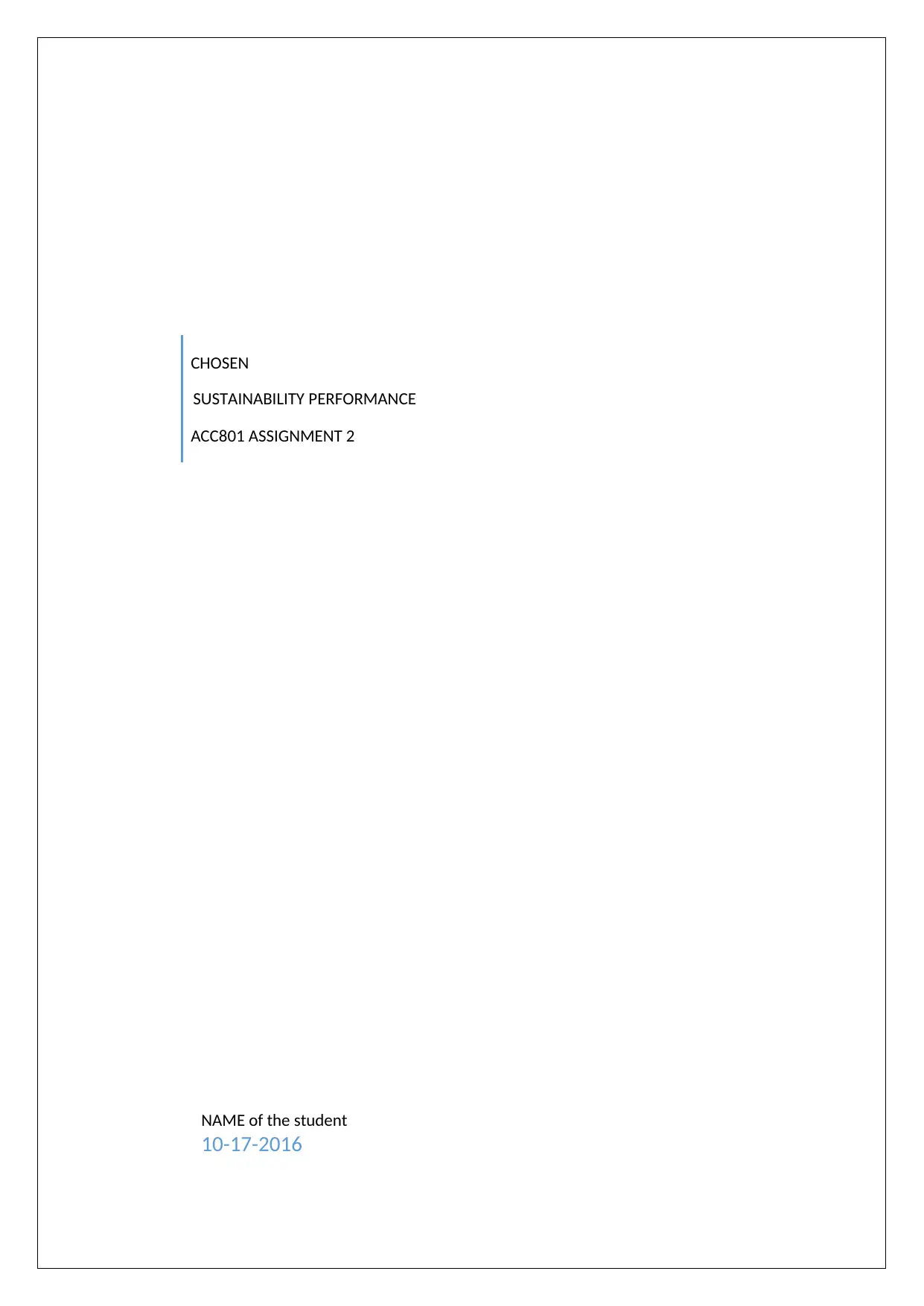
CHOSEN
SUSTAINABILITY PERFORMANCE
ACC801 ASSIGNMENT 2
NAME of the student
10-17-2016
SUSTAINABILITY PERFORMANCE
ACC801 ASSIGNMENT 2
NAME of the student
10-17-2016
Paraphrase This Document
Need a fresh take? Get an instant paraphrase of this document with our AI Paraphraser
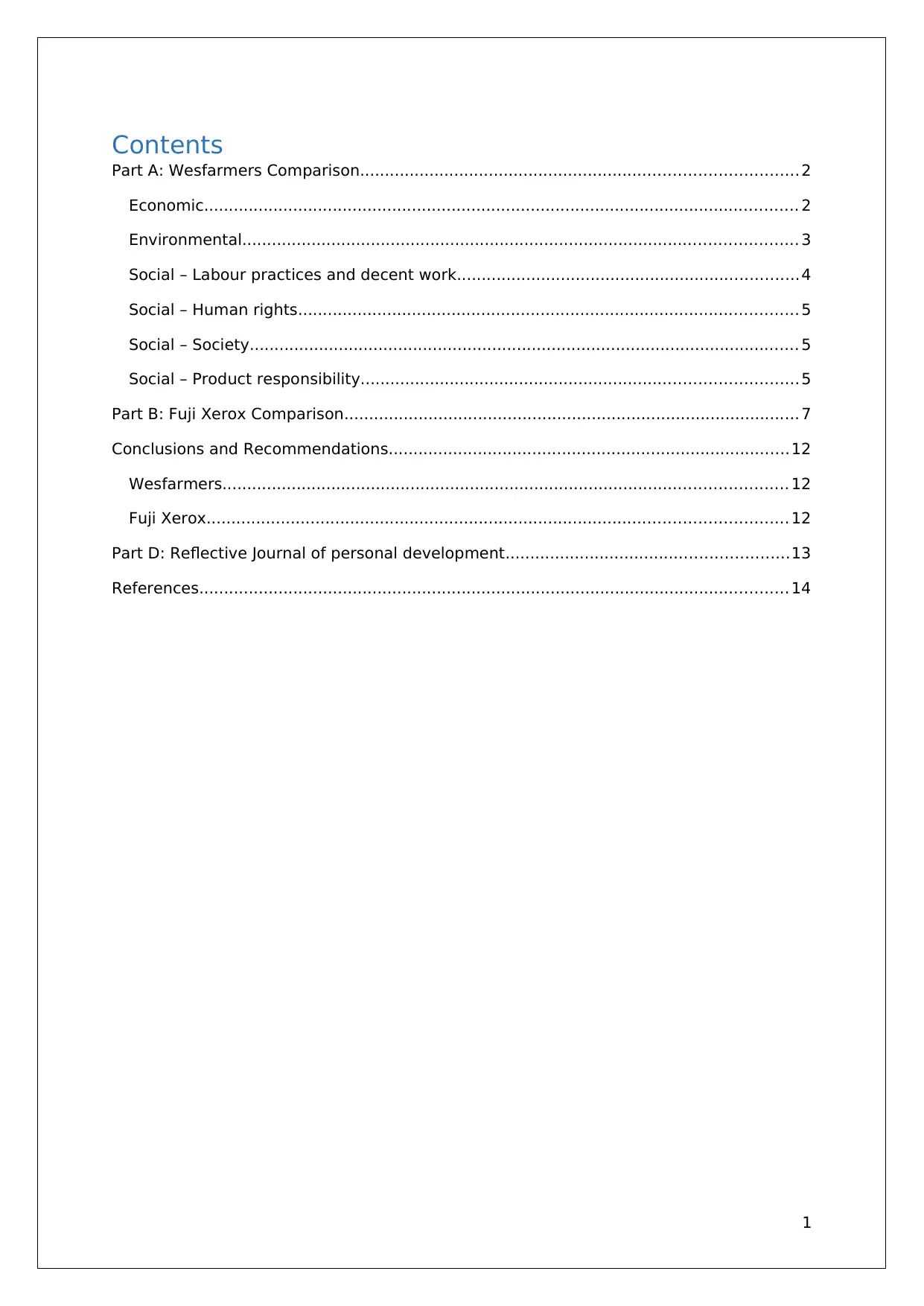
Contents
Part A: Wesfarmers Comparison........................................................................................2
Economic........................................................................................................................ 2
Environmental................................................................................................................ 3
Social – Labour practices and decent work.....................................................................4
Social – Human rights..................................................................................................... 5
Social – Society............................................................................................................... 5
Social – Product responsibility........................................................................................5
Part B: Fuji Xerox Comparison............................................................................................ 7
Conclusions and Recommendations.................................................................................12
Wesfarmers.................................................................................................................. 12
Fuji Xerox..................................................................................................................... 12
Part D: Reflective Journal of personal development.........................................................13
References....................................................................................................................... 14
1
Part A: Wesfarmers Comparison........................................................................................2
Economic........................................................................................................................ 2
Environmental................................................................................................................ 3
Social – Labour practices and decent work.....................................................................4
Social – Human rights..................................................................................................... 5
Social – Society............................................................................................................... 5
Social – Product responsibility........................................................................................5
Part B: Fuji Xerox Comparison............................................................................................ 7
Conclusions and Recommendations.................................................................................12
Wesfarmers.................................................................................................................. 12
Fuji Xerox..................................................................................................................... 12
Part D: Reflective Journal of personal development.........................................................13
References....................................................................................................................... 14
1

Part A: Wesfarmers Comparison
Wesfarmers is a leading metallurgical coal producer and supplier of thermal coal for
power generation in Australia. Wesfarmers has been publishing its Sustainability report
with focus ranging from financial performance to sustainable business practices in
carbon and energy, community support, environment, governance and economic
contribution. Wesfarmers has further refined its report in 2014 to include such areas
material to the stakeholders as communicated by them during stakeholder engagement
conducted on a regular basis in a manner consistent with the principles of the Global
Reporting Initiative (GRI). GRI requires businesses to report on areas which are material
to both the organisation and its stakeholders. (Wesfarmers, 2014 Sustainability Report).
The sustainable performance for Wesfarmers for 2014 and 2015 has been analysed
under the categories of:
a. Economic
b. Environmental
c. Social
The category social is further analysed into aspects of:
a. Labour practices and decent work
b. Human rights
c. Society
d. Product Responsibility
The analysis is as below:
Economic
The G4-EC1 guideline requires the business to report and disclose the economic value
generated and distributed. These needs to be in details as per the basis components
of the statement of profit or loss at the global and significant regional level. G4 –EC5
requires the business to report analytical ratios of standard wages by gender in
relation to local minimum wage at significant locations of operations. Wesfarmers
have provided the details in respect of G4-EC1. The company has highlighted that its
operations has resulted in net outflow of monies to the suppliers amounting to $43
million, to 205,000 employees amounting to $7.8 million, to government amounting
to $1.6 million in the form taxes and to the shareholders amounting to $2.2 million in
the form of dividends. This has been a steady performance as compared to 2014
levels. No data for payments to suppliers were available for 2014. Further the direct
and indirect community contributions have increased from 2014 levels as per table
below:
2
Wesfarmers is a leading metallurgical coal producer and supplier of thermal coal for
power generation in Australia. Wesfarmers has been publishing its Sustainability report
with focus ranging from financial performance to sustainable business practices in
carbon and energy, community support, environment, governance and economic
contribution. Wesfarmers has further refined its report in 2014 to include such areas
material to the stakeholders as communicated by them during stakeholder engagement
conducted on a regular basis in a manner consistent with the principles of the Global
Reporting Initiative (GRI). GRI requires businesses to report on areas which are material
to both the organisation and its stakeholders. (Wesfarmers, 2014 Sustainability Report).
The sustainable performance for Wesfarmers for 2014 and 2015 has been analysed
under the categories of:
a. Economic
b. Environmental
c. Social
The category social is further analysed into aspects of:
a. Labour practices and decent work
b. Human rights
c. Society
d. Product Responsibility
The analysis is as below:
Economic
The G4-EC1 guideline requires the business to report and disclose the economic value
generated and distributed. These needs to be in details as per the basis components
of the statement of profit or loss at the global and significant regional level. G4 –EC5
requires the business to report analytical ratios of standard wages by gender in
relation to local minimum wage at significant locations of operations. Wesfarmers
have provided the details in respect of G4-EC1. The company has highlighted that its
operations has resulted in net outflow of monies to the suppliers amounting to $43
million, to 205,000 employees amounting to $7.8 million, to government amounting
to $1.6 million in the form taxes and to the shareholders amounting to $2.2 million in
the form of dividends. This has been a steady performance as compared to 2014
levels. No data for payments to suppliers were available for 2014. Further the direct
and indirect community contributions have increased from 2014 levels as per table
below:
2
⊘ This is a preview!⊘
Do you want full access?
Subscribe today to unlock all pages.

Trusted by 1+ million students worldwide
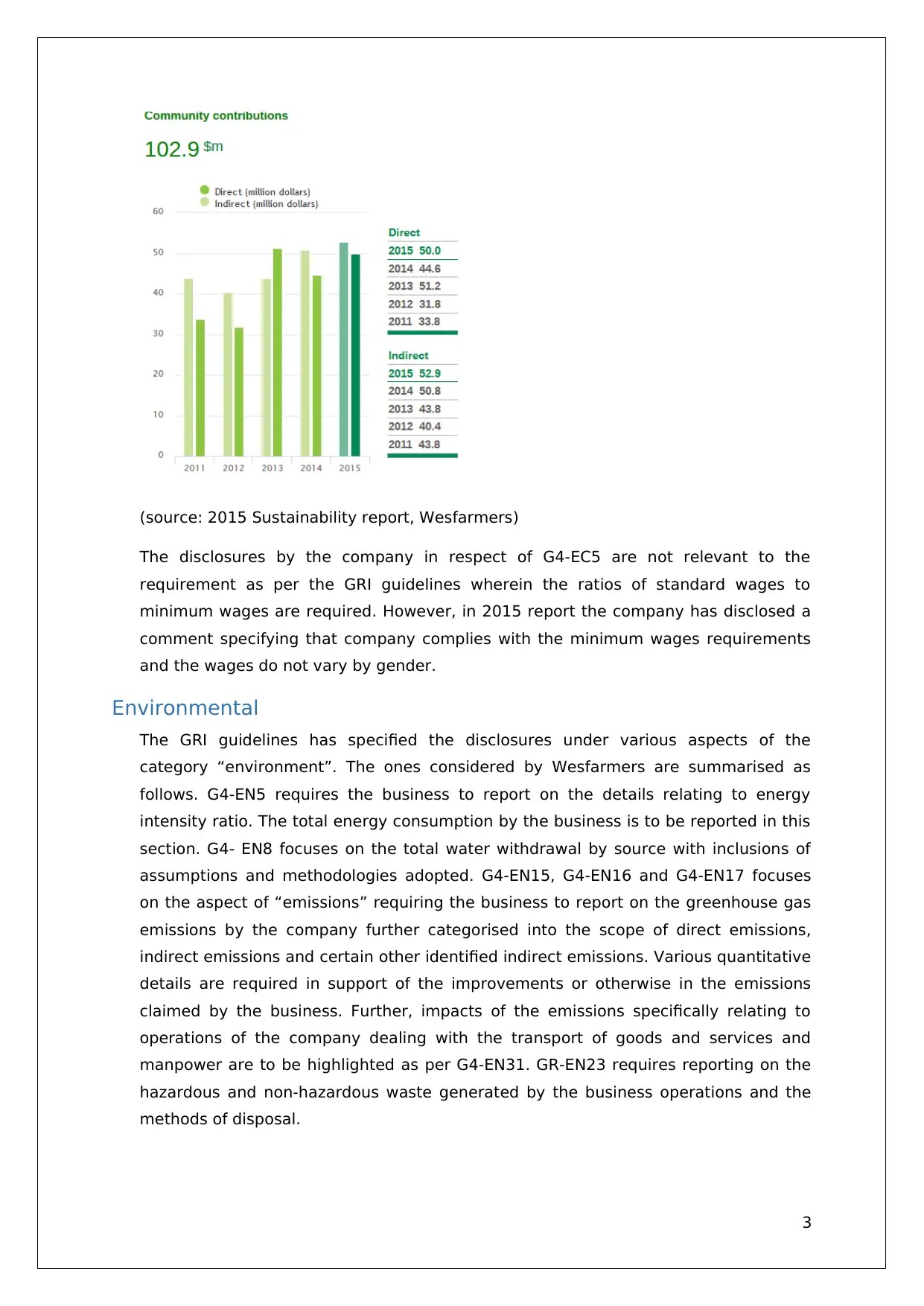
(source: 2015 Sustainability report, Wesfarmers)
The disclosures by the company in respect of G4-EC5 are not relevant to the
requirement as per the GRI guidelines wherein the ratios of standard wages to
minimum wages are required. However, in 2015 report the company has disclosed a
comment specifying that company complies with the minimum wages requirements
and the wages do not vary by gender.
Environmental
The GRI guidelines has specified the disclosures under various aspects of the
category “environment”. The ones considered by Wesfarmers are summarised as
follows. G4-EN5 requires the business to report on the details relating to energy
intensity ratio. The total energy consumption by the business is to be reported in this
section. G4- EN8 focuses on the total water withdrawal by source with inclusions of
assumptions and methodologies adopted. G4-EN15, G4-EN16 and G4-EN17 focuses
on the aspect of “emissions” requiring the business to report on the greenhouse gas
emissions by the company further categorised into the scope of direct emissions,
indirect emissions and certain other identified indirect emissions. Various quantitative
details are required in support of the improvements or otherwise in the emissions
claimed by the business. Further, impacts of the emissions specifically relating to
operations of the company dealing with the transport of goods and services and
manpower are to be highlighted as per G4-EN31. GR-EN23 requires reporting on the
hazardous and non-hazardous waste generated by the business operations and the
methods of disposal.
3
The disclosures by the company in respect of G4-EC5 are not relevant to the
requirement as per the GRI guidelines wherein the ratios of standard wages to
minimum wages are required. However, in 2015 report the company has disclosed a
comment specifying that company complies with the minimum wages requirements
and the wages do not vary by gender.
Environmental
The GRI guidelines has specified the disclosures under various aspects of the
category “environment”. The ones considered by Wesfarmers are summarised as
follows. G4-EN5 requires the business to report on the details relating to energy
intensity ratio. The total energy consumption by the business is to be reported in this
section. G4- EN8 focuses on the total water withdrawal by source with inclusions of
assumptions and methodologies adopted. G4-EN15, G4-EN16 and G4-EN17 focuses
on the aspect of “emissions” requiring the business to report on the greenhouse gas
emissions by the company further categorised into the scope of direct emissions,
indirect emissions and certain other identified indirect emissions. Various quantitative
details are required in support of the improvements or otherwise in the emissions
claimed by the business. Further, impacts of the emissions specifically relating to
operations of the company dealing with the transport of goods and services and
manpower are to be highlighted as per G4-EN31. GR-EN23 requires reporting on the
hazardous and non-hazardous waste generated by the business operations and the
methods of disposal.
3
Paraphrase This Document
Need a fresh take? Get an instant paraphrase of this document with our AI Paraphraser
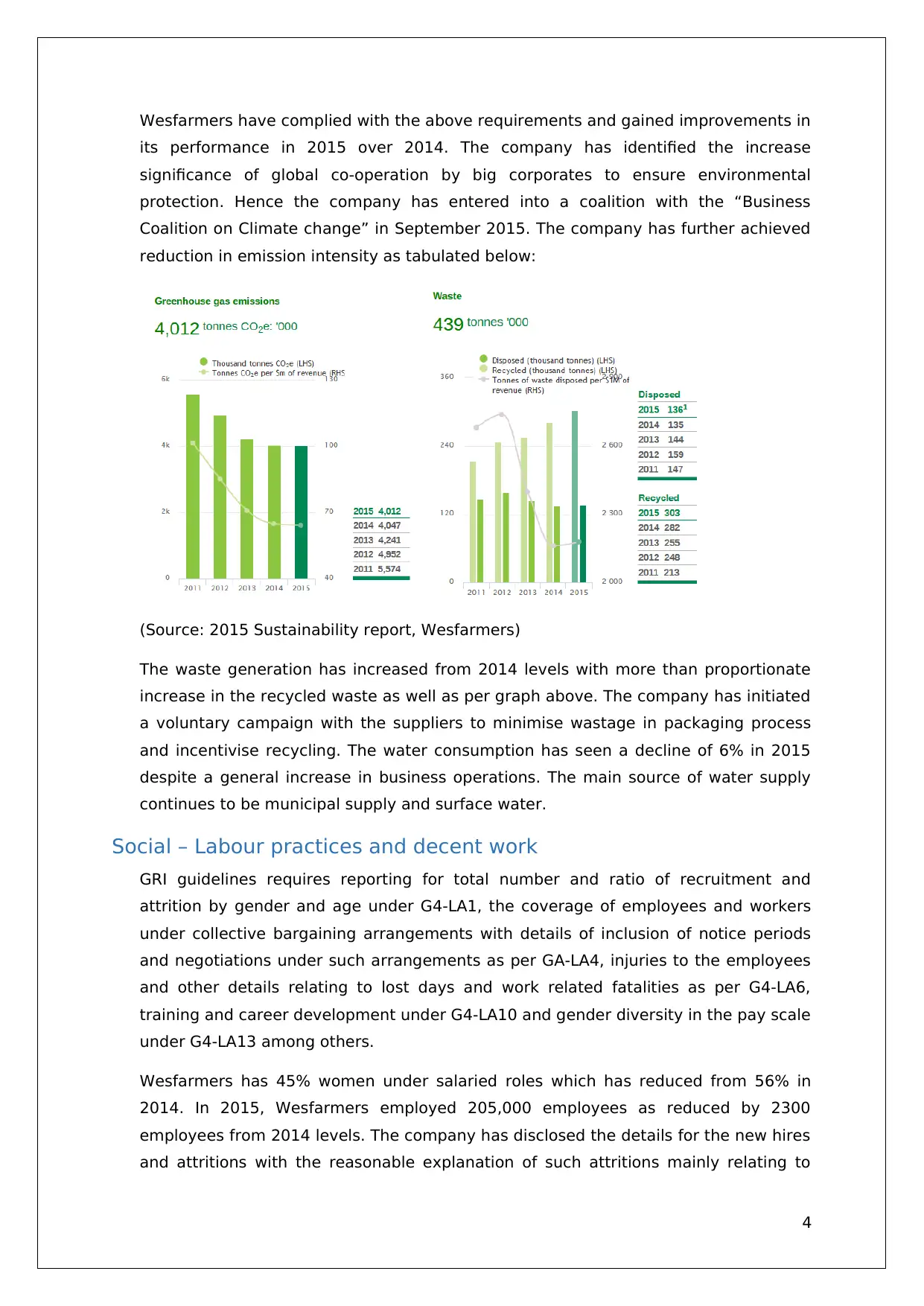
Wesfarmers have complied with the above requirements and gained improvements in
its performance in 2015 over 2014. The company has identified the increase
significance of global co-operation by big corporates to ensure environmental
protection. Hence the company has entered into a coalition with the “Business
Coalition on Climate change” in September 2015. The company has further achieved
reduction in emission intensity as tabulated below:
(Source: 2015 Sustainability report, Wesfarmers)
The waste generation has increased from 2014 levels with more than proportionate
increase in the recycled waste as well as per graph above. The company has initiated
a voluntary campaign with the suppliers to minimise wastage in packaging process
and incentivise recycling. The water consumption has seen a decline of 6% in 2015
despite a general increase in business operations. The main source of water supply
continues to be municipal supply and surface water.
Social – Labour practices and decent work
GRI guidelines requires reporting for total number and ratio of recruitment and
attrition by gender and age under G4-LA1, the coverage of employees and workers
under collective bargaining arrangements with details of inclusion of notice periods
and negotiations under such arrangements as per GA-LA4, injuries to the employees
and other details relating to lost days and work related fatalities as per G4-LA6,
training and career development under G4-LA10 and gender diversity in the pay scale
under G4-LA13 among others.
Wesfarmers has 45% women under salaried roles which has reduced from 56% in
2014. In 2015, Wesfarmers employed 205,000 employees as reduced by 2300
employees from 2014 levels. The company has disclosed the details for the new hires
and attritions with the reasonable explanation of such attritions mainly relating to
4
its performance in 2015 over 2014. The company has identified the increase
significance of global co-operation by big corporates to ensure environmental
protection. Hence the company has entered into a coalition with the “Business
Coalition on Climate change” in September 2015. The company has further achieved
reduction in emission intensity as tabulated below:
(Source: 2015 Sustainability report, Wesfarmers)
The waste generation has increased from 2014 levels with more than proportionate
increase in the recycled waste as well as per graph above. The company has initiated
a voluntary campaign with the suppliers to minimise wastage in packaging process
and incentivise recycling. The water consumption has seen a decline of 6% in 2015
despite a general increase in business operations. The main source of water supply
continues to be municipal supply and surface water.
Social – Labour practices and decent work
GRI guidelines requires reporting for total number and ratio of recruitment and
attrition by gender and age under G4-LA1, the coverage of employees and workers
under collective bargaining arrangements with details of inclusion of notice periods
and negotiations under such arrangements as per GA-LA4, injuries to the employees
and other details relating to lost days and work related fatalities as per G4-LA6,
training and career development under G4-LA10 and gender diversity in the pay scale
under G4-LA13 among others.
Wesfarmers has 45% women under salaried roles which has reduced from 56% in
2014. In 2015, Wesfarmers employed 205,000 employees as reduced by 2300
employees from 2014 levels. The company has disclosed the details for the new hires
and attritions with the reasonable explanation of such attritions mainly relating to
4

sale of Insurance division. The safety performance has improved in 2015 with 39.5
total recordable injury rate as against 42.7 in 2014. The lost time has reduced by
5.2% in 2015. The training and development initiative by the company has remained
consistent across the two periods. Wesfarmers aim for gender pay equity.
Social – Human rights
G4-HR2 requires reporting of total hours spent by the employees on the human rights
awareness. G4-HR5 requires reporting of identified risks of child labour employment
for business operations and measures to nullify such risk.
Wesfarmers has spent 2300 man hours in training for human rights in 2015 as
against 1020 hours in 2014. The factories and other places of operations are subject
to independent audits to ensure compliance. The breaches identified were acted upon
through correction or termination of the dealings with such factories.
Social – Society
GR-SO6 requires the business to report on the various political contributions made by
the company with the details of the beneficiary and the country. In case of in-kind
contributions, the valuation of such in-kind contribution in addition to the valuation
methodology adopted should be reported. GR-SO7 require the business to report on
the status of legal actions on the company in relation to malpractices alleged on it for
anti-competitive behaviour. Further, monetary and non-monetary sanctions on the
company are required to be disclosed under G4-SO8 for legal non-compliance.
Wesfarmers claims that it has suitable code of conduct and anti-bribery policies in
place to ensure that the ethical business practices are maintained. Further, there has
been no specific disclosure for such political contributions by Wesfarmers in 2014 and
2015. Wesfarmers has highlighted the cases pending in its 2015 and 2014
sustainability reports. The cases are settled as per the arbitration proceedings. The
company has disclose its settlement of fines owing to non-compliance amounting to
$2.5 million in bread litigation case and $ 10 million for supplier misconduct. There
were no major litigations concluded leading to any fines imposed on Wesfarmers in
2014.
Social – Product responsibility
G4-PR1 requires the company to report the products and services categories which
are identified as to having negative health and safety impacts. This section is not
applicable to Wesfarmers as health concerns are identified at division level and not at
product category level. There are no disclosures for this in both 2014 and 2015.
G4-PR2 requires product category wise reporting of incidents of non-compliance with
regulation in relation got health and safety of the products. The company has not
5
total recordable injury rate as against 42.7 in 2014. The lost time has reduced by
5.2% in 2015. The training and development initiative by the company has remained
consistent across the two periods. Wesfarmers aim for gender pay equity.
Social – Human rights
G4-HR2 requires reporting of total hours spent by the employees on the human rights
awareness. G4-HR5 requires reporting of identified risks of child labour employment
for business operations and measures to nullify such risk.
Wesfarmers has spent 2300 man hours in training for human rights in 2015 as
against 1020 hours in 2014. The factories and other places of operations are subject
to independent audits to ensure compliance. The breaches identified were acted upon
through correction or termination of the dealings with such factories.
Social – Society
GR-SO6 requires the business to report on the various political contributions made by
the company with the details of the beneficiary and the country. In case of in-kind
contributions, the valuation of such in-kind contribution in addition to the valuation
methodology adopted should be reported. GR-SO7 require the business to report on
the status of legal actions on the company in relation to malpractices alleged on it for
anti-competitive behaviour. Further, monetary and non-monetary sanctions on the
company are required to be disclosed under G4-SO8 for legal non-compliance.
Wesfarmers claims that it has suitable code of conduct and anti-bribery policies in
place to ensure that the ethical business practices are maintained. Further, there has
been no specific disclosure for such political contributions by Wesfarmers in 2014 and
2015. Wesfarmers has highlighted the cases pending in its 2015 and 2014
sustainability reports. The cases are settled as per the arbitration proceedings. The
company has disclose its settlement of fines owing to non-compliance amounting to
$2.5 million in bread litigation case and $ 10 million for supplier misconduct. There
were no major litigations concluded leading to any fines imposed on Wesfarmers in
2014.
Social – Product responsibility
G4-PR1 requires the company to report the products and services categories which
are identified as to having negative health and safety impacts. This section is not
applicable to Wesfarmers as health concerns are identified at division level and not at
product category level. There are no disclosures for this in both 2014 and 2015.
G4-PR2 requires product category wise reporting of incidents of non-compliance with
regulation in relation got health and safety of the products. The company has not
5
⊘ This is a preview!⊘
Do you want full access?
Subscribe today to unlock all pages.

Trusted by 1+ million students worldwide
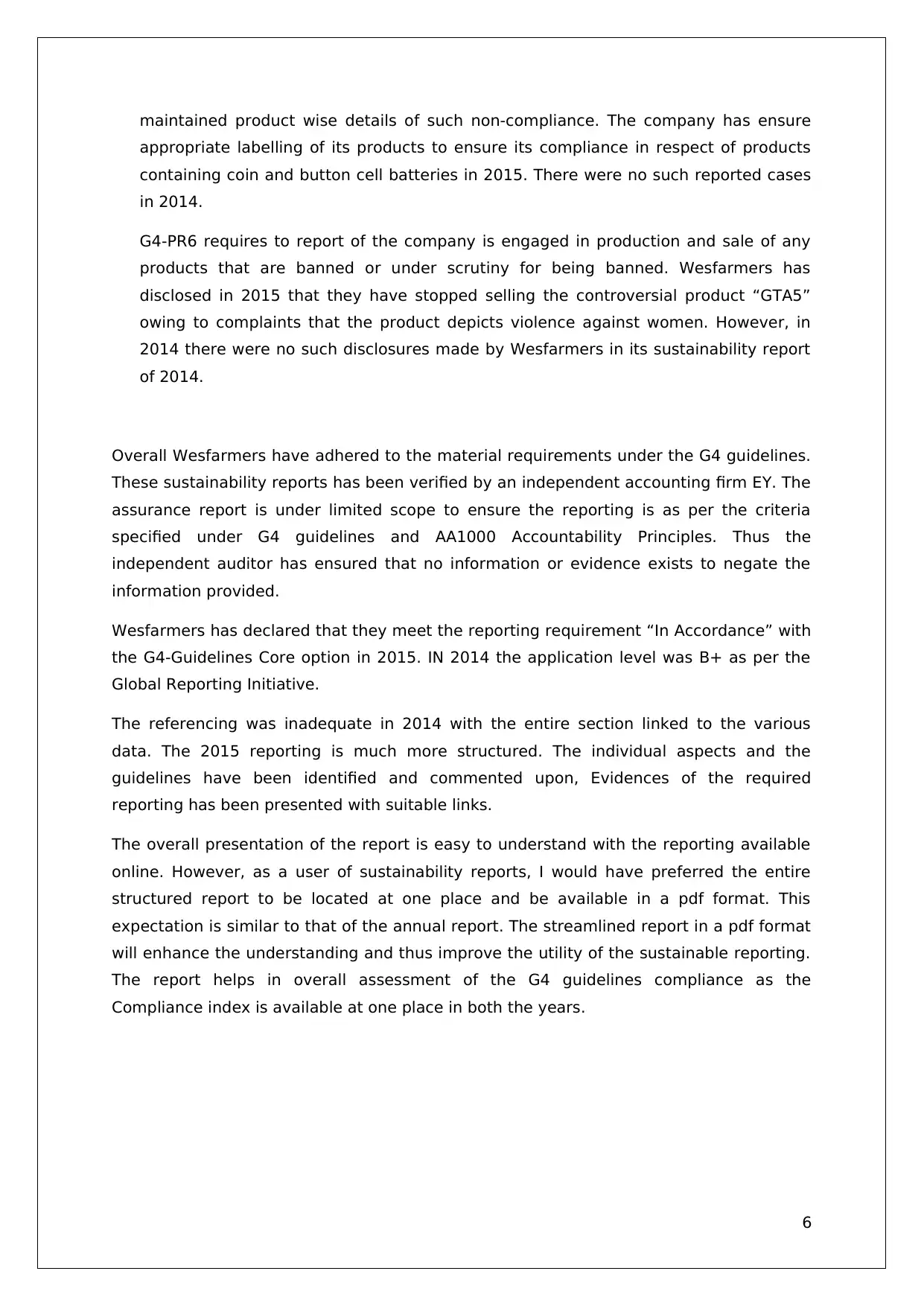
maintained product wise details of such non-compliance. The company has ensure
appropriate labelling of its products to ensure its compliance in respect of products
containing coin and button cell batteries in 2015. There were no such reported cases
in 2014.
G4-PR6 requires to report of the company is engaged in production and sale of any
products that are banned or under scrutiny for being banned. Wesfarmers has
disclosed in 2015 that they have stopped selling the controversial product “GTA5”
owing to complaints that the product depicts violence against women. However, in
2014 there were no such disclosures made by Wesfarmers in its sustainability report
of 2014.
Overall Wesfarmers have adhered to the material requirements under the G4 guidelines.
These sustainability reports has been verified by an independent accounting firm EY. The
assurance report is under limited scope to ensure the reporting is as per the criteria
specified under G4 guidelines and AA1000 Accountability Principles. Thus the
independent auditor has ensured that no information or evidence exists to negate the
information provided.
Wesfarmers has declared that they meet the reporting requirement “In Accordance” with
the G4-Guidelines Core option in 2015. IN 2014 the application level was B+ as per the
Global Reporting Initiative.
The referencing was inadequate in 2014 with the entire section linked to the various
data. The 2015 reporting is much more structured. The individual aspects and the
guidelines have been identified and commented upon, Evidences of the required
reporting has been presented with suitable links.
The overall presentation of the report is easy to understand with the reporting available
online. However, as a user of sustainability reports, I would have preferred the entire
structured report to be located at one place and be available in a pdf format. This
expectation is similar to that of the annual report. The streamlined report in a pdf format
will enhance the understanding and thus improve the utility of the sustainable reporting.
The report helps in overall assessment of the G4 guidelines compliance as the
Compliance index is available at one place in both the years.
6
appropriate labelling of its products to ensure its compliance in respect of products
containing coin and button cell batteries in 2015. There were no such reported cases
in 2014.
G4-PR6 requires to report of the company is engaged in production and sale of any
products that are banned or under scrutiny for being banned. Wesfarmers has
disclosed in 2015 that they have stopped selling the controversial product “GTA5”
owing to complaints that the product depicts violence against women. However, in
2014 there were no such disclosures made by Wesfarmers in its sustainability report
of 2014.
Overall Wesfarmers have adhered to the material requirements under the G4 guidelines.
These sustainability reports has been verified by an independent accounting firm EY. The
assurance report is under limited scope to ensure the reporting is as per the criteria
specified under G4 guidelines and AA1000 Accountability Principles. Thus the
independent auditor has ensured that no information or evidence exists to negate the
information provided.
Wesfarmers has declared that they meet the reporting requirement “In Accordance” with
the G4-Guidelines Core option in 2015. IN 2014 the application level was B+ as per the
Global Reporting Initiative.
The referencing was inadequate in 2014 with the entire section linked to the various
data. The 2015 reporting is much more structured. The individual aspects and the
guidelines have been identified and commented upon, Evidences of the required
reporting has been presented with suitable links.
The overall presentation of the report is easy to understand with the reporting available
online. However, as a user of sustainability reports, I would have preferred the entire
structured report to be located at one place and be available in a pdf format. This
expectation is similar to that of the annual report. The streamlined report in a pdf format
will enhance the understanding and thus improve the utility of the sustainable reporting.
The report helps in overall assessment of the G4 guidelines compliance as the
Compliance index is available at one place in both the years.
6
Paraphrase This Document
Need a fresh take? Get an instant paraphrase of this document with our AI Paraphraser
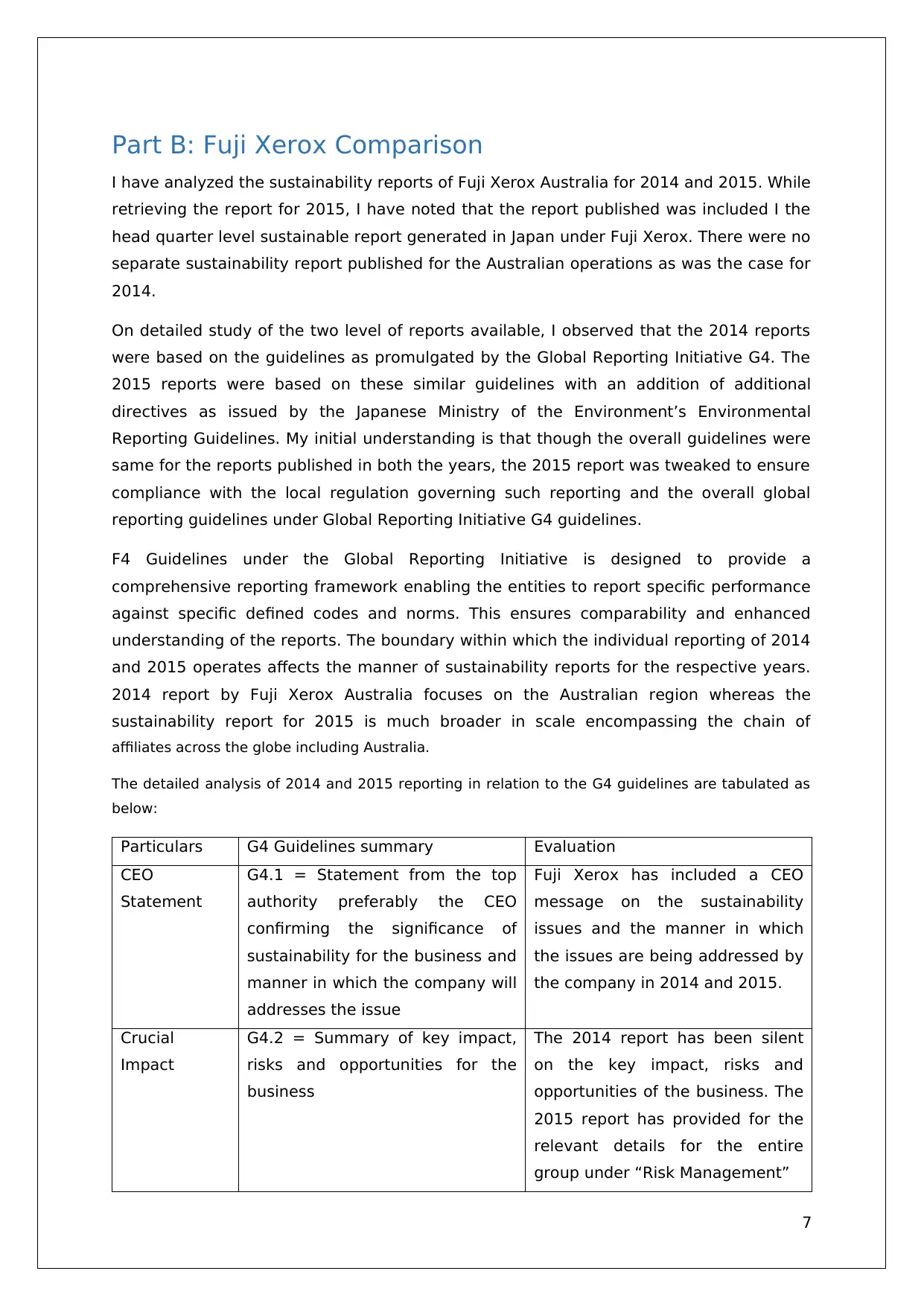
Part B: Fuji Xerox Comparison
I have analyzed the sustainability reports of Fuji Xerox Australia for 2014 and 2015. While
retrieving the report for 2015, I have noted that the report published was included I the
head quarter level sustainable report generated in Japan under Fuji Xerox. There were no
separate sustainability report published for the Australian operations as was the case for
2014.
On detailed study of the two level of reports available, I observed that the 2014 reports
were based on the guidelines as promulgated by the Global Reporting Initiative G4. The
2015 reports were based on these similar guidelines with an addition of additional
directives as issued by the Japanese Ministry of the Environment’s Environmental
Reporting Guidelines. My initial understanding is that though the overall guidelines were
same for the reports published in both the years, the 2015 report was tweaked to ensure
compliance with the local regulation governing such reporting and the overall global
reporting guidelines under Global Reporting Initiative G4 guidelines.
F4 Guidelines under the Global Reporting Initiative is designed to provide a
comprehensive reporting framework enabling the entities to report specific performance
against specific defined codes and norms. This ensures comparability and enhanced
understanding of the reports. The boundary within which the individual reporting of 2014
and 2015 operates affects the manner of sustainability reports for the respective years.
2014 report by Fuji Xerox Australia focuses on the Australian region whereas the
sustainability report for 2015 is much broader in scale encompassing the chain of
affiliates across the globe including Australia.
The detailed analysis of 2014 and 2015 reporting in relation to the G4 guidelines are tabulated as
below:
Particulars G4 Guidelines summary Evaluation
CEO
Statement
G4.1 = Statement from the top
authority preferably the CEO
confirming the significance of
sustainability for the business and
manner in which the company will
addresses the issue
Fuji Xerox has included a CEO
message on the sustainability
issues and the manner in which
the issues are being addressed by
the company in 2014 and 2015.
Crucial
Impact
G4.2 = Summary of key impact,
risks and opportunities for the
business
The 2014 report has been silent
on the key impact, risks and
opportunities of the business. The
2015 report has provided for the
relevant details for the entire
group under “Risk Management”
7
I have analyzed the sustainability reports of Fuji Xerox Australia for 2014 and 2015. While
retrieving the report for 2015, I have noted that the report published was included I the
head quarter level sustainable report generated in Japan under Fuji Xerox. There were no
separate sustainability report published for the Australian operations as was the case for
2014.
On detailed study of the two level of reports available, I observed that the 2014 reports
were based on the guidelines as promulgated by the Global Reporting Initiative G4. The
2015 reports were based on these similar guidelines with an addition of additional
directives as issued by the Japanese Ministry of the Environment’s Environmental
Reporting Guidelines. My initial understanding is that though the overall guidelines were
same for the reports published in both the years, the 2015 report was tweaked to ensure
compliance with the local regulation governing such reporting and the overall global
reporting guidelines under Global Reporting Initiative G4 guidelines.
F4 Guidelines under the Global Reporting Initiative is designed to provide a
comprehensive reporting framework enabling the entities to report specific performance
against specific defined codes and norms. This ensures comparability and enhanced
understanding of the reports. The boundary within which the individual reporting of 2014
and 2015 operates affects the manner of sustainability reports for the respective years.
2014 report by Fuji Xerox Australia focuses on the Australian region whereas the
sustainability report for 2015 is much broader in scale encompassing the chain of
affiliates across the globe including Australia.
The detailed analysis of 2014 and 2015 reporting in relation to the G4 guidelines are tabulated as
below:
Particulars G4 Guidelines summary Evaluation
CEO
Statement
G4.1 = Statement from the top
authority preferably the CEO
confirming the significance of
sustainability for the business and
manner in which the company will
addresses the issue
Fuji Xerox has included a CEO
message on the sustainability
issues and the manner in which
the issues are being addressed by
the company in 2014 and 2015.
Crucial
Impact
G4.2 = Summary of key impact,
risks and opportunities for the
business
The 2014 report has been silent
on the key impact, risks and
opportunities of the business. The
2015 report has provided for the
relevant details for the entire
group under “Risk Management”
7

Other details
of the entity
G4.3 = The name of the entity,
brands
G4.4 = products and services
G4.5 = locations of the
headquarters
G4.6 = countries of operations
G4.7 = the ownership of the entity
G4.8 = the markets
G4.9 = scale of operations
G4.13 = Changes to the size,
structure or ownership
Fuji Xerox has provided a detailed
disclosure in 2014 and 2015
However for G4.13 there has been
no change in 2015 and hence not
reflected in 2015 reporting. In
2014 the changes pertaining to
the supply chain has been
referenced and disclosed
Workforce
data
G4.10 = Various parameters of
employee strength
G4.11 = Coverage of the
workforce under collective
enterprise agreements
The sustainability report
published for year 2014 focuses
on Australian Data while the
similar report for 2015 is much
broader encompassing within
itself the global business including
Australia.
Supply chain G4.12 = Description of the supply
chain
The sustainability report provides
the required details for both the
years.
Memberships
and
associations
G4.16 = A detailed list of
membership to the association of
the entity
The 2015 disclosure is very
generic. 2014 disclosure is much
more detailed with individual
memberships duly briefed upon.
Other
Structure
G4.17 = analysis of its operational
structure and a comprehensive
list of its subsidiaries and network
companies and affiliates
Both the reports provide
respective structure details of the
subsidiaries and is adequate.
Report
content and
its procedure
G4.18 = The company needs to
provide the process adopted for
defining the report content
G4.19 = the material aspects
identified
G4.20 = the aspect boundary
within the entity for each
identified material aspect
G4.21 = the aspect boundary
outside the entity for each
The sustainability report provides
the required data in both the
years and is adequate.
8
of the entity
G4.3 = The name of the entity,
brands
G4.4 = products and services
G4.5 = locations of the
headquarters
G4.6 = countries of operations
G4.7 = the ownership of the entity
G4.8 = the markets
G4.9 = scale of operations
G4.13 = Changes to the size,
structure or ownership
Fuji Xerox has provided a detailed
disclosure in 2014 and 2015
However for G4.13 there has been
no change in 2015 and hence not
reflected in 2015 reporting. In
2014 the changes pertaining to
the supply chain has been
referenced and disclosed
Workforce
data
G4.10 = Various parameters of
employee strength
G4.11 = Coverage of the
workforce under collective
enterprise agreements
The sustainability report
published for year 2014 focuses
on Australian Data while the
similar report for 2015 is much
broader encompassing within
itself the global business including
Australia.
Supply chain G4.12 = Description of the supply
chain
The sustainability report provides
the required details for both the
years.
Memberships
and
associations
G4.16 = A detailed list of
membership to the association of
the entity
The 2015 disclosure is very
generic. 2014 disclosure is much
more detailed with individual
memberships duly briefed upon.
Other
Structure
G4.17 = analysis of its operational
structure and a comprehensive
list of its subsidiaries and network
companies and affiliates
Both the reports provide
respective structure details of the
subsidiaries and is adequate.
Report
content and
its procedure
G4.18 = The company needs to
provide the process adopted for
defining the report content
G4.19 = the material aspects
identified
G4.20 = the aspect boundary
within the entity for each
identified material aspect
G4.21 = the aspect boundary
outside the entity for each
The sustainability report provides
the required data in both the
years and is adequate.
8
⊘ This is a preview!⊘
Do you want full access?
Subscribe today to unlock all pages.

Trusted by 1+ million students worldwide
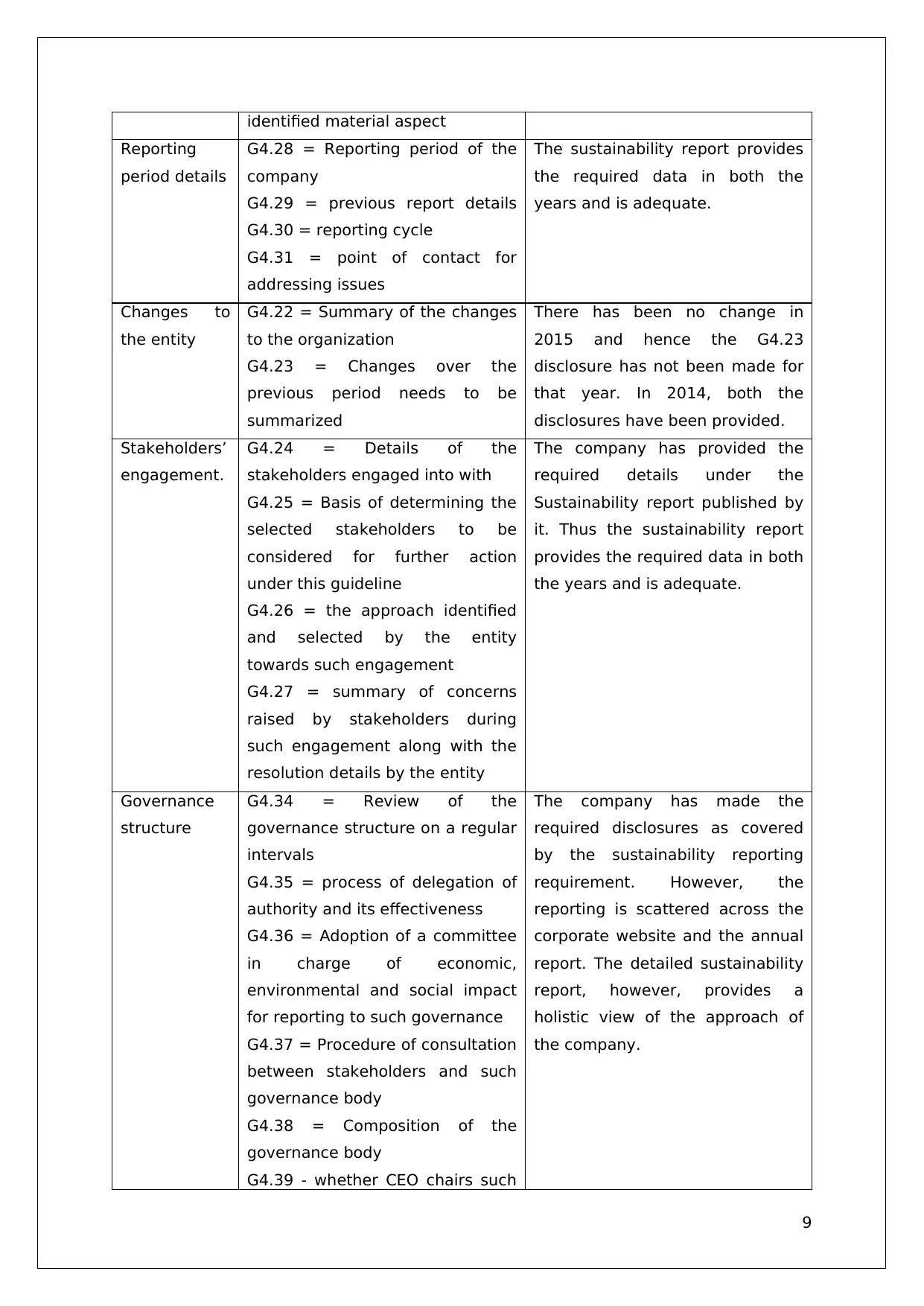
identified material aspect
Reporting
period details
G4.28 = Reporting period of the
company
G4.29 = previous report details
G4.30 = reporting cycle
G4.31 = point of contact for
addressing issues
The sustainability report provides
the required data in both the
years and is adequate.
Changes to
the entity
G4.22 = Summary of the changes
to the organization
G4.23 = Changes over the
previous period needs to be
summarized
There has been no change in
2015 and hence the G4.23
disclosure has not been made for
that year. In 2014, both the
disclosures have been provided.
Stakeholders’
engagement.
G4.24 = Details of the
stakeholders engaged into with
G4.25 = Basis of determining the
selected stakeholders to be
considered for further action
under this guideline
G4.26 = the approach identified
and selected by the entity
towards such engagement
G4.27 = summary of concerns
raised by stakeholders during
such engagement along with the
resolution details by the entity
The company has provided the
required details under the
Sustainability report published by
it. Thus the sustainability report
provides the required data in both
the years and is adequate.
Governance
structure
G4.34 = Review of the
governance structure on a regular
intervals
G4.35 = process of delegation of
authority and its effectiveness
G4.36 = Adoption of a committee
in charge of economic,
environmental and social impact
for reporting to such governance
G4.37 = Procedure of consultation
between stakeholders and such
governance body
G4.38 = Composition of the
governance body
G4.39 - whether CEO chairs such
The company has made the
required disclosures as covered
by the sustainability reporting
requirement. However, the
reporting is scattered across the
corporate website and the annual
report. The detailed sustainability
report, however, provides a
holistic view of the approach of
the company.
9
Reporting
period details
G4.28 = Reporting period of the
company
G4.29 = previous report details
G4.30 = reporting cycle
G4.31 = point of contact for
addressing issues
The sustainability report provides
the required data in both the
years and is adequate.
Changes to
the entity
G4.22 = Summary of the changes
to the organization
G4.23 = Changes over the
previous period needs to be
summarized
There has been no change in
2015 and hence the G4.23
disclosure has not been made for
that year. In 2014, both the
disclosures have been provided.
Stakeholders’
engagement.
G4.24 = Details of the
stakeholders engaged into with
G4.25 = Basis of determining the
selected stakeholders to be
considered for further action
under this guideline
G4.26 = the approach identified
and selected by the entity
towards such engagement
G4.27 = summary of concerns
raised by stakeholders during
such engagement along with the
resolution details by the entity
The company has provided the
required details under the
Sustainability report published by
it. Thus the sustainability report
provides the required data in both
the years and is adequate.
Governance
structure
G4.34 = Review of the
governance structure on a regular
intervals
G4.35 = process of delegation of
authority and its effectiveness
G4.36 = Adoption of a committee
in charge of economic,
environmental and social impact
for reporting to such governance
G4.37 = Procedure of consultation
between stakeholders and such
governance body
G4.38 = Composition of the
governance body
G4.39 - whether CEO chairs such
The company has made the
required disclosures as covered
by the sustainability reporting
requirement. However, the
reporting is scattered across the
corporate website and the annual
report. The detailed sustainability
report, however, provides a
holistic view of the approach of
the company.
9
Paraphrase This Document
Need a fresh take? Get an instant paraphrase of this document with our AI Paraphraser
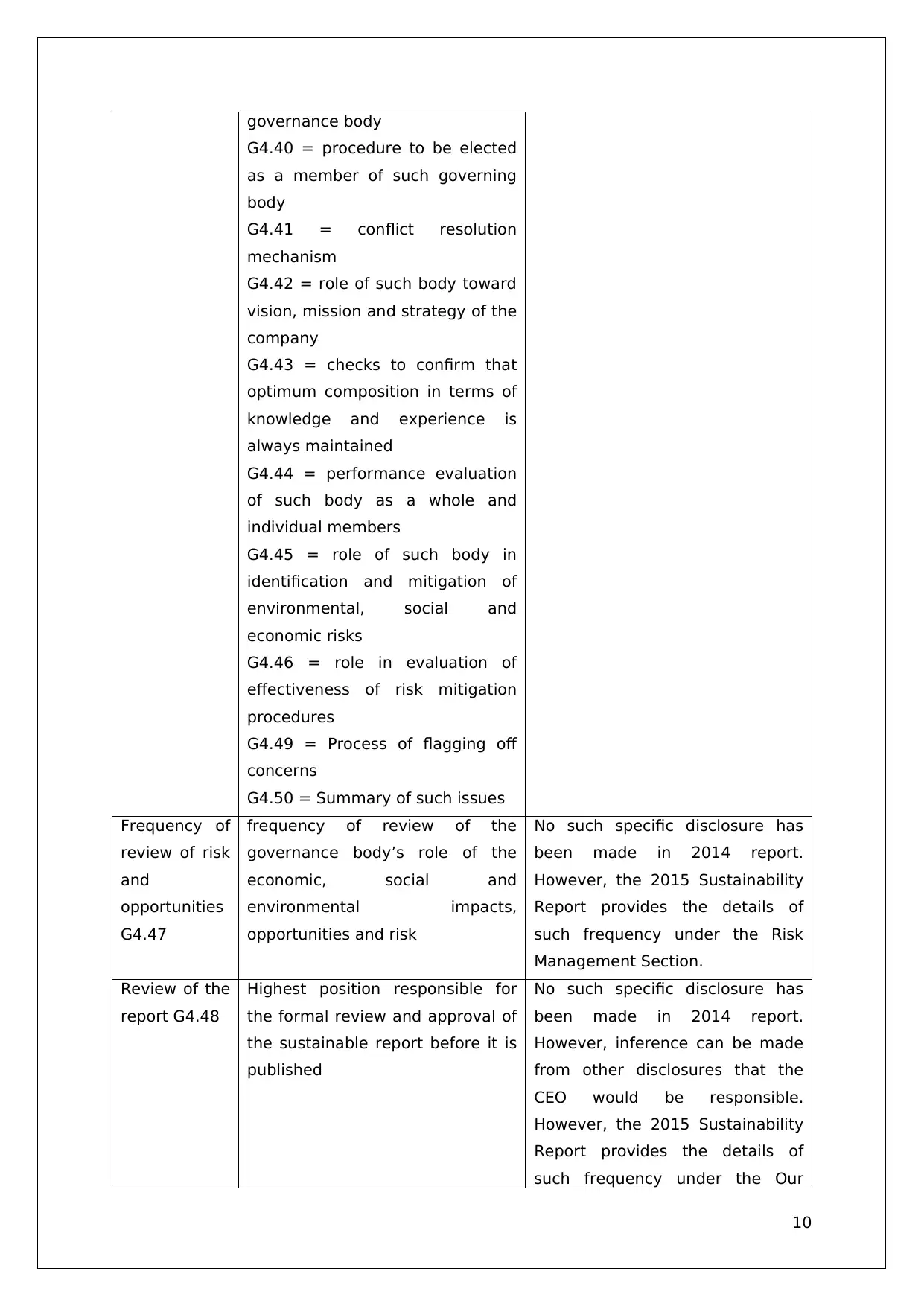
governance body
G4.40 = procedure to be elected
as a member of such governing
body
G4.41 = conflict resolution
mechanism
G4.42 = role of such body toward
vision, mission and strategy of the
company
G4.43 = checks to confirm that
optimum composition in terms of
knowledge and experience is
always maintained
G4.44 = performance evaluation
of such body as a whole and
individual members
G4.45 = role of such body in
identification and mitigation of
environmental, social and
economic risks
G4.46 = role in evaluation of
effectiveness of risk mitigation
procedures
G4.49 = Process of flagging off
concerns
G4.50 = Summary of such issues
Frequency of
review of risk
and
opportunities
G4.47
frequency of review of the
governance body’s role of the
economic, social and
environmental impacts,
opportunities and risk
No such specific disclosure has
been made in 2014 report.
However, the 2015 Sustainability
Report provides the details of
such frequency under the Risk
Management Section.
Review of the
report G4.48
Highest position responsible for
the formal review and approval of
the sustainable report before it is
published
No such specific disclosure has
been made in 2014 report.
However, inference can be made
from other disclosures that the
CEO would be responsible.
However, the 2015 Sustainability
Report provides the details of
such frequency under the Our
10
G4.40 = procedure to be elected
as a member of such governing
body
G4.41 = conflict resolution
mechanism
G4.42 = role of such body toward
vision, mission and strategy of the
company
G4.43 = checks to confirm that
optimum composition in terms of
knowledge and experience is
always maintained
G4.44 = performance evaluation
of such body as a whole and
individual members
G4.45 = role of such body in
identification and mitigation of
environmental, social and
economic risks
G4.46 = role in evaluation of
effectiveness of risk mitigation
procedures
G4.49 = Process of flagging off
concerns
G4.50 = Summary of such issues
Frequency of
review of risk
and
opportunities
G4.47
frequency of review of the
governance body’s role of the
economic, social and
environmental impacts,
opportunities and risk
No such specific disclosure has
been made in 2014 report.
However, the 2015 Sustainability
Report provides the details of
such frequency under the Risk
Management Section.
Review of the
report G4.48
Highest position responsible for
the formal review and approval of
the sustainable report before it is
published
No such specific disclosure has
been made in 2014 report.
However, inference can be made
from other disclosures that the
CEO would be responsible.
However, the 2015 Sustainability
Report provides the details of
such frequency under the Our
10
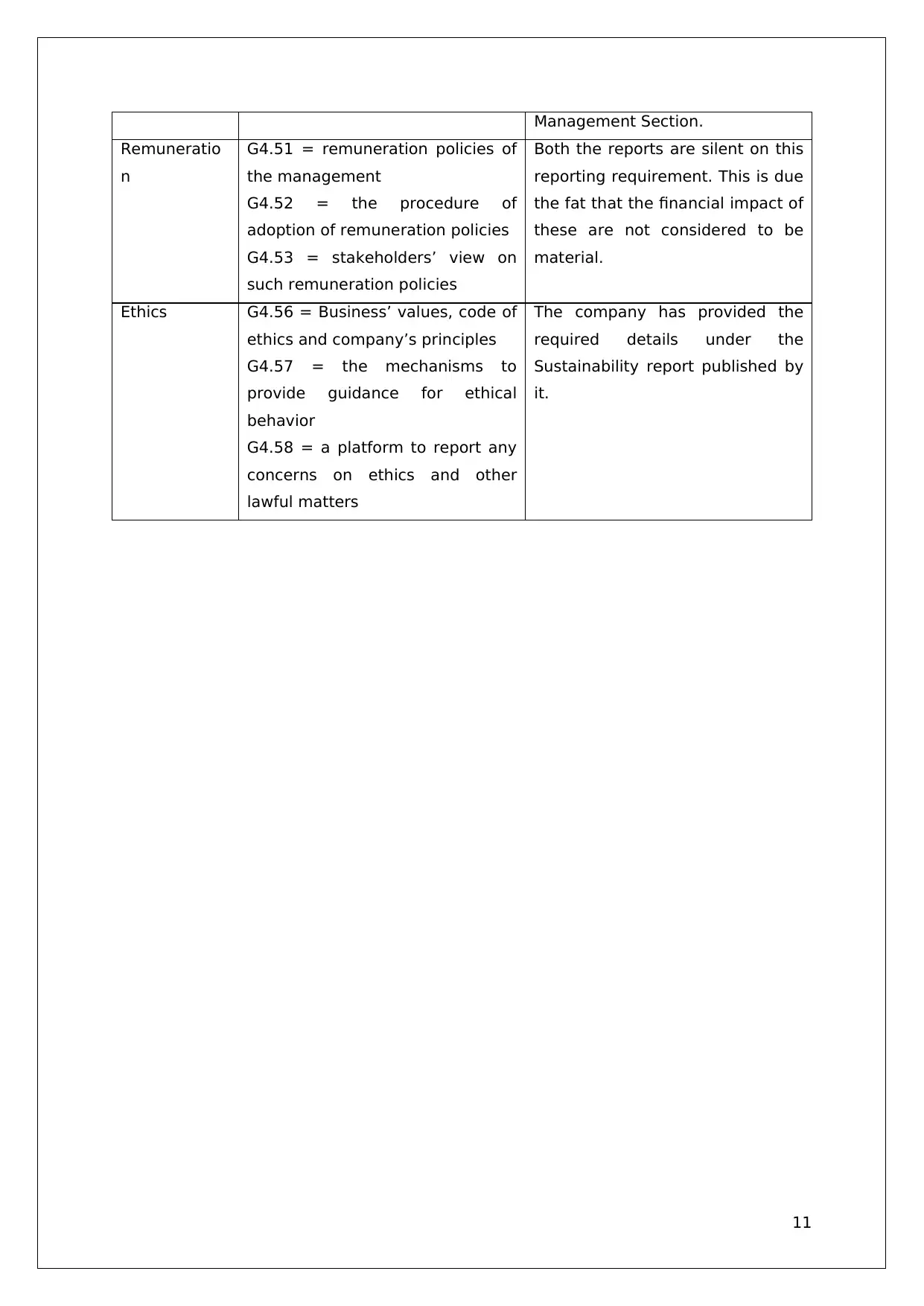
Management Section.
Remuneratio
n
G4.51 = remuneration policies of
the management
G4.52 = the procedure of
adoption of remuneration policies
G4.53 = stakeholders’ view on
such remuneration policies
Both the reports are silent on this
reporting requirement. This is due
the fat that the financial impact of
these are not considered to be
material.
Ethics G4.56 = Business’ values, code of
ethics and company’s principles
G4.57 = the mechanisms to
provide guidance for ethical
behavior
G4.58 = a platform to report any
concerns on ethics and other
lawful matters
The company has provided the
required details under the
Sustainability report published by
it.
11
Remuneratio
n
G4.51 = remuneration policies of
the management
G4.52 = the procedure of
adoption of remuneration policies
G4.53 = stakeholders’ view on
such remuneration policies
Both the reports are silent on this
reporting requirement. This is due
the fat that the financial impact of
these are not considered to be
material.
Ethics G4.56 = Business’ values, code of
ethics and company’s principles
G4.57 = the mechanisms to
provide guidance for ethical
behavior
G4.58 = a platform to report any
concerns on ethics and other
lawful matters
The company has provided the
required details under the
Sustainability report published by
it.
11
⊘ This is a preview!⊘
Do you want full access?
Subscribe today to unlock all pages.

Trusted by 1+ million students worldwide

Conclusions and Recommendations
Wesfarmers
The sustainability reporting for Wesfarmers have seen an improvement in 2015 over
2014. I have noted that the compliance index is much more descriptive and in line with
the specific guidelines of G4. The reports are available online in a scattered manner and
hence loose the important quality of ensuring understanding and keeping it simple. I
believe that the report should be also published in the form and manner of an annual
report of the Company. The pdf format of sustainable reports will enhance the user value
of such reports for my use. The company has not provided details on the percentage of
product categories for various reporting as it analyses and stores data on a division
basis. In such cases, Wesfarmers has specified a disclaimer that the required provisions
are not applicable. In these cases I recommend that the company should disclose the
details in the form and manner and in such detail available by the company. The
company should ensure going forward that the details are available at the level required
under G4 guidelines. Without the availability of such data, I believe that it would not be
prudent to conclude that the output would not be meaningful. Thus Wesfarmers should
strive to ensure that the data is available to the details required under G4.
Fuji Xerox
The sustainability report of Fuji Xerox for both the years has implied difference of the
scope. The 2014 report is much more decentralized and focuses on the Australian Entity
and its operations within Australia. 2015 report, on the other hand, is much broader in
scope and covers global operations under the umbrella of the Headquarters based in
Japan. The 2015 Sustainability Report considers the local environmental regulations and
reporting requirements of Japan in its scope. Thus the analysis and details provided for in
2015 report is much more comprehensive reflecting the underlying complex base of
operations in multiple countries.
The Sustainability Reports for both the years is streamlined under the umbrella principles
as provided by the Global Reporting Initiative G-4 Guidelines. The overall output may be
similar but the report for 2015 is much more complex.
12
Wesfarmers
The sustainability reporting for Wesfarmers have seen an improvement in 2015 over
2014. I have noted that the compliance index is much more descriptive and in line with
the specific guidelines of G4. The reports are available online in a scattered manner and
hence loose the important quality of ensuring understanding and keeping it simple. I
believe that the report should be also published in the form and manner of an annual
report of the Company. The pdf format of sustainable reports will enhance the user value
of such reports for my use. The company has not provided details on the percentage of
product categories for various reporting as it analyses and stores data on a division
basis. In such cases, Wesfarmers has specified a disclaimer that the required provisions
are not applicable. In these cases I recommend that the company should disclose the
details in the form and manner and in such detail available by the company. The
company should ensure going forward that the details are available at the level required
under G4 guidelines. Without the availability of such data, I believe that it would not be
prudent to conclude that the output would not be meaningful. Thus Wesfarmers should
strive to ensure that the data is available to the details required under G4.
Fuji Xerox
The sustainability report of Fuji Xerox for both the years has implied difference of the
scope. The 2014 report is much more decentralized and focuses on the Australian Entity
and its operations within Australia. 2015 report, on the other hand, is much broader in
scope and covers global operations under the umbrella of the Headquarters based in
Japan. The 2015 Sustainability Report considers the local environmental regulations and
reporting requirements of Japan in its scope. Thus the analysis and details provided for in
2015 report is much more comprehensive reflecting the underlying complex base of
operations in multiple countries.
The Sustainability Reports for both the years is streamlined under the umbrella principles
as provided by the Global Reporting Initiative G-4 Guidelines. The overall output may be
similar but the report for 2015 is much more complex.
12
Paraphrase This Document
Need a fresh take? Get an instant paraphrase of this document with our AI Paraphraser
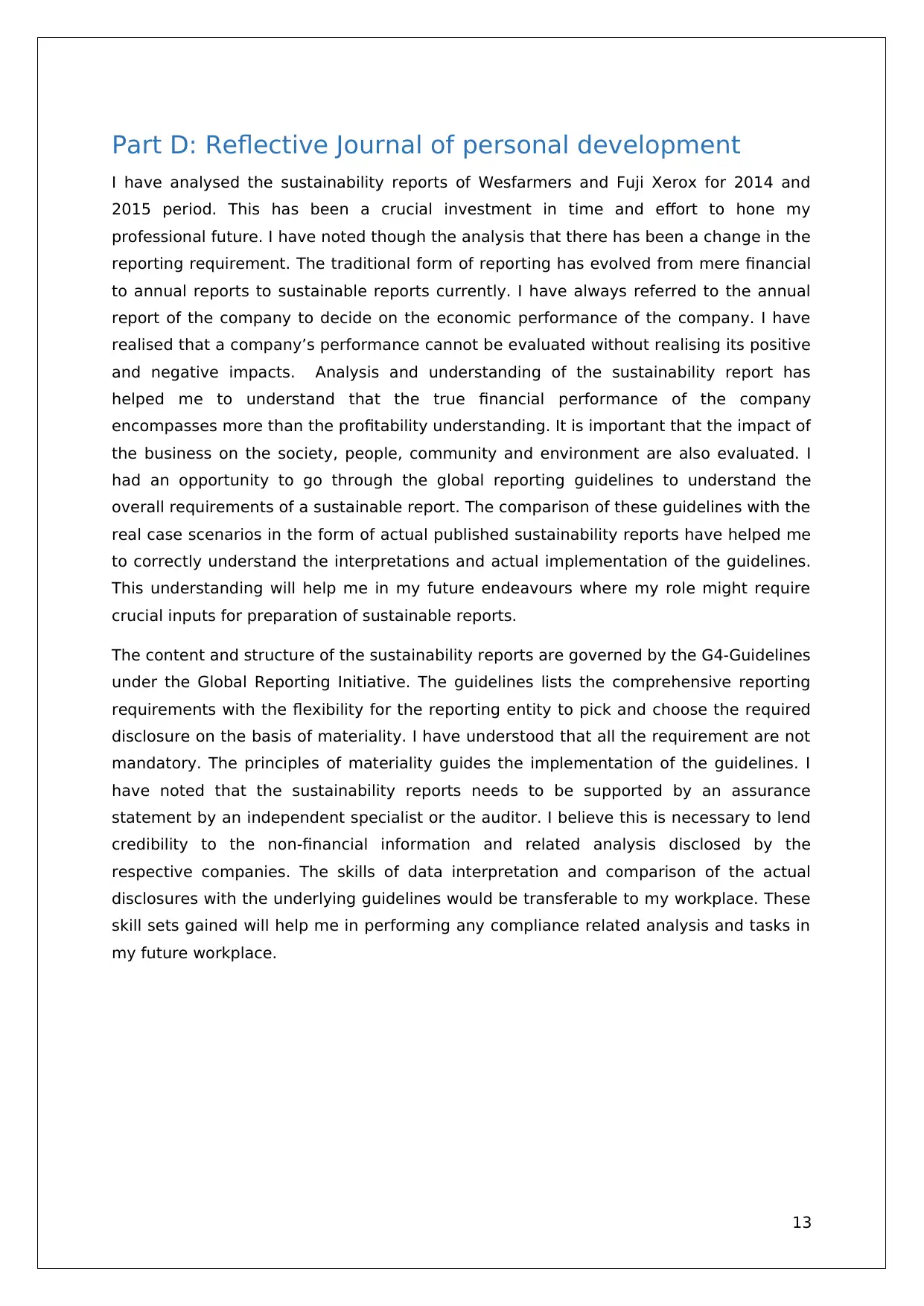
Part D: Reflective Journal of personal development
I have analysed the sustainability reports of Wesfarmers and Fuji Xerox for 2014 and
2015 period. This has been a crucial investment in time and effort to hone my
professional future. I have noted though the analysis that there has been a change in the
reporting requirement. The traditional form of reporting has evolved from mere financial
to annual reports to sustainable reports currently. I have always referred to the annual
report of the company to decide on the economic performance of the company. I have
realised that a company’s performance cannot be evaluated without realising its positive
and negative impacts. Analysis and understanding of the sustainability report has
helped me to understand that the true financial performance of the company
encompasses more than the profitability understanding. It is important that the impact of
the business on the society, people, community and environment are also evaluated. I
had an opportunity to go through the global reporting guidelines to understand the
overall requirements of a sustainable report. The comparison of these guidelines with the
real case scenarios in the form of actual published sustainability reports have helped me
to correctly understand the interpretations and actual implementation of the guidelines.
This understanding will help me in my future endeavours where my role might require
crucial inputs for preparation of sustainable reports.
The content and structure of the sustainability reports are governed by the G4-Guidelines
under the Global Reporting Initiative. The guidelines lists the comprehensive reporting
requirements with the flexibility for the reporting entity to pick and choose the required
disclosure on the basis of materiality. I have understood that all the requirement are not
mandatory. The principles of materiality guides the implementation of the guidelines. I
have noted that the sustainability reports needs to be supported by an assurance
statement by an independent specialist or the auditor. I believe this is necessary to lend
credibility to the non-financial information and related analysis disclosed by the
respective companies. The skills of data interpretation and comparison of the actual
disclosures with the underlying guidelines would be transferable to my workplace. These
skill sets gained will help me in performing any compliance related analysis and tasks in
my future workplace.
13
I have analysed the sustainability reports of Wesfarmers and Fuji Xerox for 2014 and
2015 period. This has been a crucial investment in time and effort to hone my
professional future. I have noted though the analysis that there has been a change in the
reporting requirement. The traditional form of reporting has evolved from mere financial
to annual reports to sustainable reports currently. I have always referred to the annual
report of the company to decide on the economic performance of the company. I have
realised that a company’s performance cannot be evaluated without realising its positive
and negative impacts. Analysis and understanding of the sustainability report has
helped me to understand that the true financial performance of the company
encompasses more than the profitability understanding. It is important that the impact of
the business on the society, people, community and environment are also evaluated. I
had an opportunity to go through the global reporting guidelines to understand the
overall requirements of a sustainable report. The comparison of these guidelines with the
real case scenarios in the form of actual published sustainability reports have helped me
to correctly understand the interpretations and actual implementation of the guidelines.
This understanding will help me in my future endeavours where my role might require
crucial inputs for preparation of sustainable reports.
The content and structure of the sustainability reports are governed by the G4-Guidelines
under the Global Reporting Initiative. The guidelines lists the comprehensive reporting
requirements with the flexibility for the reporting entity to pick and choose the required
disclosure on the basis of materiality. I have understood that all the requirement are not
mandatory. The principles of materiality guides the implementation of the guidelines. I
have noted that the sustainability reports needs to be supported by an assurance
statement by an independent specialist or the auditor. I believe this is necessary to lend
credibility to the non-financial information and related analysis disclosed by the
respective companies. The skills of data interpretation and comparison of the actual
disclosures with the underlying guidelines would be transferable to my workplace. These
skill sets gained will help me in performing any compliance related analysis and tasks in
my future workplace.
13
1 out of 14
Your All-in-One AI-Powered Toolkit for Academic Success.
+13062052269
info@desklib.com
Available 24*7 on WhatsApp / Email
![[object Object]](/_next/static/media/star-bottom.7253800d.svg)
Unlock your academic potential
© 2024 | Zucol Services PVT LTD | All rights reserved.


